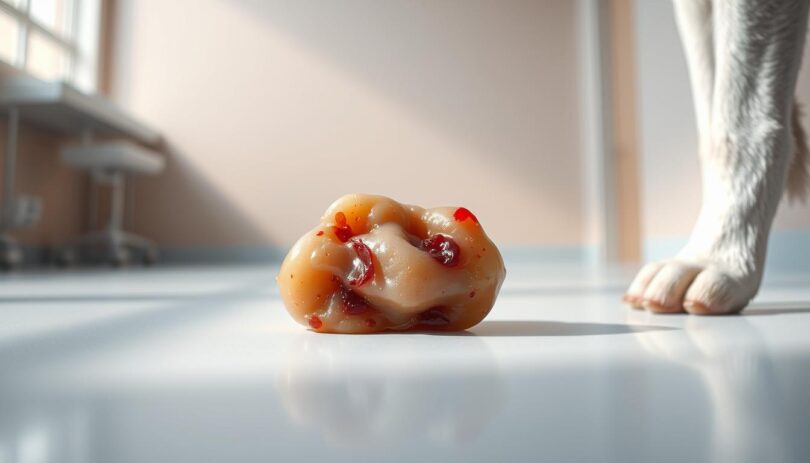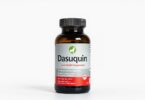Did you know 30% of veterinary visits involve digestive issues? When a pet’s stool appears jelly-like with red streaks, it often signals inflammation or bleeding in the lower intestines. This texture, combined with mucus, points to conditions like colitis—a common but concerning problem requiring attention.
Stool consistency and color act as critical health clues. Healthy feces should be firm and chocolate brown. Reddish streaks or tarry textures suggest different issues—from minor dietary upsets to infections. Monitoring these changes helps distinguish temporary discomfort from emergencies like hemorrhagic gastroenteritis.
Common triggers include parasites, sudden diet shifts, or stress. While some cases resolve quickly, others demand immediate care. Pet owners should track patterns: How often does it happen? Are there behavioral changes? Early detection improves outcomes and reduces risks of complications.
This guide explores causes, treatment options, and prevention strategies. You’ll learn how to assess stool characteristics, when to contact a vet, and ways to support your companion’s digestive health. Let’s start with understanding what these signs mean—and why timely action matters.
Recognizing Different Appearances of Bloody Dog Stool
Spotting unusual changes in your pet’s waste can reveal critical clues about their health. Two key terms help identify the source of bleeding: hematochezia (fresh red blood) and melena (digested dark blood). Understanding these differences guides better decisions for care.
Fresh Streaks vs. Tarry Texture
Hematochezia appears as bright red streaks or spots, often coating the stool’s surface. This signals bleeding in the lower intestines or rectum—common with colitis or parasites. Experts compare this appearance to a “strawberry milkshake” texture when mucus mixes with blood.
Melena, however, creates black, sticky stools resembling tar. This occurs when blood digests in the upper gastrointestinal tract, like the stomach. It’s linked to ulcers or ingestion of harmful substances. Consistency matters too: jelly-like stools suggest inflammation, while watery ones may indicate infections.
Subtle Shifts in Form and Color
Even minor changes matter. A single red speck could mean anal gland irritation, while repeated bloody mucus warrants a vet visit. Track whether stools soften gradually or shift abruptly—sudden jelly-like textures often point to acute distress.
Identifying Warning Signs and Symptoms
Your pet’s behavior often holds clues to hidden health issues. Beyond unusual stool textures, watch for patterns like repeated vomiting or sudden energy drops. These signals help separate minor upsets from serious conditions needing professional care.
Additional Indicators of Gastrointestinal Distress
Lethargy and refusal to eat often accompany digestive problems. Dehydration—visible through dry gums or reduced skin elasticity—can develop quickly with frequent diarrhea. Pair these with trembling or abdominal discomfort, and it’s time to act.
Track how often symptoms occur. A single loose stool might not alarm you, but three episodes in six hours demand attention. Blood streaks mixed with mucus often indicate inflammation, while watery consistency suggests infections.
When to Monitor and Record Changes
Document details like stool color, frequency, and accompanying signs. Snap photos or jot notes—this data helps veterinarians pinpoint causes faster. For example, timing vomiting episodes after meals could reveal food sensitivities.
Even mild cases require vigilance. If safe solutions for diarrhea don’t resolve issues within 24 hours, consult your vet. Early intervention prevents complications like nutrient loss or organ strain.
Common Causes Behind Dog Poop Like Jelly with Blood
Nearly 1 in 5 pets experience gastrointestinal bleeding during their lifetime. This alarming symptom often stems from irritation or damage to the digestive tract. Identifying the root issue helps owners respond appropriately—whether through dietary adjustments or emergency care.
Understanding Gastrointestinal Bleeding
Bleeding in the stomach or intestines often appears as red streaks or mucus-coated stools. Bacterial infections like salmonella or campylobacter are frequent culprits, inflaming the bowel lining. Parasites such as hookworms can also damage intestinal walls, leading to blood loss.
Physical trauma—like swallowing sharp objects—creates internal injuries. Accidental ingestion of toxins (rat poison, toxic plants) may trigger clotting disorders. In severe cases, tumors or ulcers cause slow, hidden bleeding requiring urgent diagnosis.
Veterinary studies show rectal injuries from constipation or foreign bodies often resolve with care. However, dark, tarry stools signal upper digestive bleeding linked to organ failure risks. Tracking symptom duration helps vets prioritize testing for life-threatening conditions.
Owners should note accompanying signs: vomiting, appetite changes, or lethargy. While minor infections might clear naturally, persistent bloody mucus warrants professional evaluation. Quick action prevents complications like anemia or dehydration.
Dietary Factors and Food-Related Triggers
A pet’s diet forms the cornerstone of digestive health. What they eat directly impacts gut function and stool quality. When unusual textures or colors appear, food-related triggers often play a key role—especially when paired with sudden behavioral shifts.
Sudden Diet Changes and Food Indiscretion
Abrupt shifts in meals disrupt delicate gut bacteria. Switching kibble brands overnight or introducing rich treats can overwhelm the digestive system. This dietary indiscretion often leads to mucus-covered stools or loose consistency within hours.
Scavenging behaviors worsen risks. Consuming spoiled food, trash, or non-food items irritates intestinal linings. Experts recommend transitioning diets over 5-7 days: mix 25% new food with 75% current meals, increasing gradually. This method reduces stress on enzymes and microbiome balance.
Food Allergies and Intolerances
Chronic inflammation often stems from ingredient sensitivities. Proteins like beef or chicken frequently trigger immune responses, causing bowel irritation. Unlike sudden dietary changes, allergy-related symptoms persist until problematic foods are eliminated.
Common signs include frequent diarrhea, vomiting, or skin issues. Veterinarians often suggest elimination diets—feeding novel proteins like venison for 8-12 weeks—to identify culprits. Keeping a food journal helps track reactions and pinpoint dietary causes efficiently.
Infections, Parasites, and Inflammatory Conditions
Hidden threats to your pet's gut health often lurk in microscopic forms. Bacterial, viral, and parasitic invaders frequently trigger bloody stools by damaging delicate digestive tissues. Meanwhile, chronic inflammatory conditions create persistent challenges requiring specialized care.
Bacterial and Viral Causes
Pathogens like salmonella or parvovirus attack intestinal cells, causing inflammation and bleeding. These infections often lead to sudden diarrhea with red streaks. Puppies and senior pets face higher risks due to weaker immune defenses.
Parvovirus specifically destroys the gut lining, creating life-threatening fluid loss. Early symptoms include lethargy and foul-smelling stools. Immediate veterinary care improves survival chances through IV fluids and antibiotics.
Inflammatory Bowel Disease and Parasitic Infections
Inflammatory bowel disease (IBD) differs from temporary irritation. It involves chronic immune responses that thicken intestinal walls, impairing nutrient absorption. Pets with IBD often cycle between normal stools and mucus-covered episodes.
Parasites like hookworms anchor to intestinal walls, feeding on blood. This creates small wounds that leak into waste. Regular deworming prevents these stealthy invaders from causing anemia or stunted growth.
Veterinarians use fecal exams to detect parasites and blood tests to confirm IBD. Catching these issues early allows tailored treatments—from antiparasitic medications to hypoallergenic diets. Consistent monitoring helps manage chronic conditions effectively.
Identifying Emergency Signs and When to Consult a Vet
Recognizing critical symptoms early can save your pet’s life during gastrointestinal crises. While some issues resolve with rest, others demand immediate professional attention. Knowing the difference helps prevent life-threatening complications.
Symptoms Requiring Urgent Medical Attention
Excessive blood in stool—especially bright red streaks coating multiple bowel movements—signals potential internal damage. Pair this with repeated vomiting or collapse, and it’s time to rush to the vet. Pale gums, rapid breathing, or cold limbs indicate shock, often linked to severe dehydration or blood loss.
Conditions like bloody diarrhea dogs experience can worsen within hours. Watch for unresponsiveness or inability to stand—these suggest systemic failure. Even if diarrhea seems mild initially, persistent episodes paired with lethargy require evaluation.
Owners should never ignore dark, tarry stools or jelly-like textures with clots. These often point to upper gastrointestinal bleeding or clotting disorders. Timely intervention improves outcomes: studies show pets treated within 6 hours of symptom onset recover faster.
When in doubt, contact your veterinarian. Better safe than sorry—professional guidance ensures your companion gets the care they need before conditions escalate.
At-Home Care and Supportive Measures
Supportive home care can often address minor digestive upsets before they escalate. Start by offering a 12-24 hour fasting period to let the gastrointestinal tract rest, followed by bland meals like boiled chicken and rice. Gradually reintroduce regular food over 3-5 days to avoid further irritation.
Managing Mild Cases and Home Remedies
Probiotic supplements or canned pumpkin (not pie filling) may help firm stools naturally. Ensure constant access to fresh water to prevent dehydration. Track bowel movement frequency and consistency—improvement should appear within 48 hours. If symptoms persist, consult your veterinarian before continuing home treatment.
When Professional Intervention is Necessary
Seek emergency care if your companion shows rapid breathing, pale gums, or collapses. Blood-streaked diarrhea lasting over 48 hours or containing clots requires immediate evaluation. Vets often recommend diagnostic tests like fecal exams or bloodwork to rule out parasites, infections, or internal injuries.
Document all observations—including appetite changes and energy levels—to help professionals assess severity. While temporary dietary adjustments can resolve mild issues, persistent bleeding or lethargy signals deeper health concerns needing expert attention.
Final Takeaways for a Healthy Dog
Your pet’s digestive health reflects their overall wellness. Recognizing changes in stool texture, color, and accompanying symptoms helps identify issues early—whether temporary irritation or serious conditions requiring treatment.
Consistent monitoring matters. Track frequency, consistency, and unusual elements like mucus or red streaks. Pair observations with behavioral shifts: reduced appetite or lethargy often signal deeper problems. A balanced diet prevents many triggers—transition foods gradually and avoid table scraps.
Preventive care saves lives. Schedule annual check-ups to detect hidden bowel disease or colon concerns. Routine fecal tests spot parasites before they cause blood loss. For acute cases like persistent diarrhea or bloody stools, seek veterinary guidance immediately.
Empowered owners make all the difference. Proactive measures—quality nutrition, stress reduction, and prompt action—build resilience against digestive challenges. Remember: Your attentiveness paired with expert care ensures a happier, healthier companion.
FAQ
What causes jelly-like blood in a dog’s stool?
This symptom often points to gastrointestinal issues like parasites (e.g., hookworms), bacterial infections (salmonella), or inflammatory bowel disease. Dietary indiscretion, such as eating spoiled food, can also trigger mucus-covered bloody stools. Immediate veterinary evaluation is crucial to rule out severe conditions.
How can I tell if blood in my pet’s stool is an emergency?
Seek urgent care if your dog shows weakness, pale gums, black/tarry stools, or vomiting alongside bloody diarrhea. These signs may indicate internal bleeding, parvovirus, or toxin exposure. Rapid dehydration in puppies or senior pets also warrants emergency visits.
Can food allergies cause bloody diarrhea in dogs?
Yes. Ingredients like beef, chicken, or wheat may trigger allergic reactions, leading to colitis or inflammation. A vet might recommend elimination diets or hypoallergenic formulas from brands like Royal Canin to identify and manage triggers.
Are home remedies safe for mild cases of bloody stool?
For minor issues from dietary slips, vets may suggest a 12–24-hour fast followed by bland meals (boiled chicken, rice). However, never delay professional care if symptoms persist beyond 24 hours or worsen. Hydration support with unflavored Pedialyte can help under veterinary guidance.










Leave a Comment